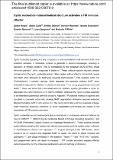Files in this item
Cyclic nucleotide-induced helical structure activates a TIR immune effector
Item metadata
| dc.contributor.author | Hogrel, Gaëlle | |
| dc.contributor.author | Guild, Abbie | |
| dc.contributor.author | Graham, Shirley | |
| dc.contributor.author | Rickman, Hannah | |
| dc.contributor.author | Grüschow, Sabine | |
| dc.contributor.author | Bertrand, Quentin | |
| dc.contributor.author | Spagnolo, Laura | |
| dc.contributor.author | White, Malcolm F. | |
| dc.date.accessioned | 2023-02-10T00:43:29Z | |
| dc.date.available | 2023-02-10T00:43:29Z | |
| dc.date.issued | 2022-08-25 | |
| dc.identifier | 280912903 | |
| dc.identifier | f45d725e-cc80-44da-bbad-999ea0abb9b6 | |
| dc.identifier | 85134531889 | |
| dc.identifier | 35948638 | |
| dc.identifier | 000838682300010 | |
| dc.identifier.citation | Hogrel , G , Guild , A , Graham , S , Rickman , H , Grüschow , S , Bertrand , Q , Spagnolo , L & White , M F 2022 , ' Cyclic nucleotide-induced helical structure activates a TIR immune effector ' , Nature , vol. 608 , no. 7924 , pp. 808–812 . https://doi.org/10.1038/s41586-022-05070-9 | en |
| dc.identifier.issn | 1476-4687 | |
| dc.identifier.other | RIS: urn:932FFE03FA7716FB932BAA3B768397DD | |
| dc.identifier.other | RIS: Hogrel2022 | |
| dc.identifier.other | ORCID: /0000-0003-1543-9342/work/117568545 | |
| dc.identifier.uri | https://hdl.handle.net/10023/26945 | |
| dc.description | Funding: This work was financed by the Biotechnology and Biological Sciences Research Council (references BB/S000313 and BB/T004789) and a European Research Council Advanced Grant (grant number 101018608) to M.F.W. We acknowledge the Scottish Centre for Macromolecular Imaging, M. Clarke and J. Streetley for assistance with cryo-EM experiments and access to instrumentation, financed by the Medical Research Council (MC_PC_17135) and the Scottish Funding Council (H17007). | en |
| dc.description.abstract | Cyclic nucleotide signalling is a key component of antiviral defence in all domains of life. Viral detection activates a nucleotide cyclase to generate a second messenger, resulting in activation of effector proteins. This is exemplified by the metazoan cGAS–STING innate immunity pathway1, which originated in bacteria2. These defence systems require a sensor domain to bind the cyclic nucleotide and are often coupled with an effector domain that, when activated, causes cell death by destroying essential biomolecules3. One example is the Toll/interleukin-1 receptor (TIR) domain, which degrades the essential cofactor NAD+ when activated in response to infection in plants and bacteria2,4,5 or during programmed nerve cell death6. Here we show that a bacterial antiviral defence system generates a cyclic tri-adenylate that binds to a TIR–SAVED effector, acting as the ‘glue’ to allow assembly of an extended superhelical solenoid structure. Adjacent TIR subunits interact to organize and complete a composite active site, allowing NAD+ degradation. Activation requires extended filament formation, both in vitro and in vivo. Our study highlights an example of large-scale molecular assembly controlled by cyclic nucleotides and reveals key details of the mechanism of TIR enzyme activation. | |
| dc.format.extent | 5 | |
| dc.format.extent | 5189968 | |
| dc.language.iso | eng | |
| dc.relation.ispartof | Nature | en |
| dc.subject | Bacterial immune defense system | en |
| dc.subject | Cryo-electron microscopy | en |
| dc.subject | TIR domain | en |
| dc.subject | QH426 Genetics | en |
| dc.subject | QR355 Virology | en |
| dc.subject | Biochemistry, Genetics and Molecular Biology(all) | en |
| dc.subject | DAS | en |
| dc.subject | AC | en |
| dc.subject | MCC | en |
| dc.subject.lcc | QH426 | en |
| dc.subject.lcc | QR355 | en |
| dc.title | Cyclic nucleotide-induced helical structure activates a TIR immune effector | en |
| dc.type | Journal article | en |
| dc.contributor.sponsor | European Research Council | en |
| dc.contributor.sponsor | BBSRC | en |
| dc.contributor.sponsor | BBSRC | en |
| dc.contributor.institution | University of St Andrews. School of Biology | en |
| dc.contributor.institution | University of St Andrews. Biomedical Sciences Research Complex | en |
| dc.contributor.institution | University of St Andrews. St Andrews Bioinformatics Unit | en |
| dc.identifier.doi | 10.1038/s41586-022-05070-9 | |
| dc.description.status | Peer reviewed | en |
| dc.date.embargoedUntil | 2023-02-10 | |
| dc.identifier.url | https://www.biorxiv.org/content/10.1101/2022.05.04.490601v1 | en |
| dc.identifier.grantnumber | 01018608 | en |
| dc.identifier.grantnumber | BB/S000313/1 | en |
| dc.identifier.grantnumber | BB/T004789/1 | en |
This item appears in the following Collection(s)
Items in the St Andrews Research Repository are protected by copyright, with all rights reserved, unless otherwise indicated.

